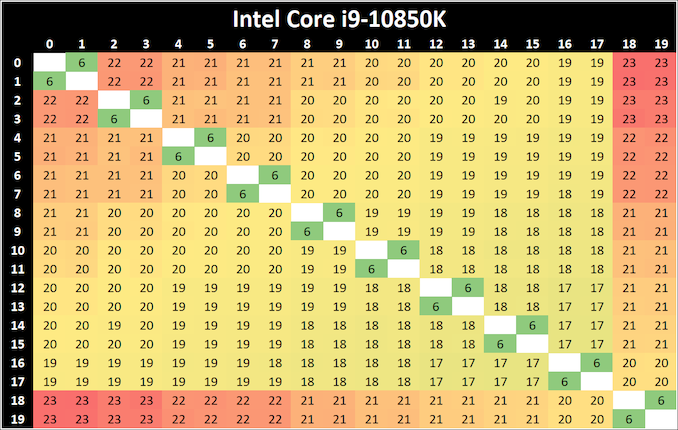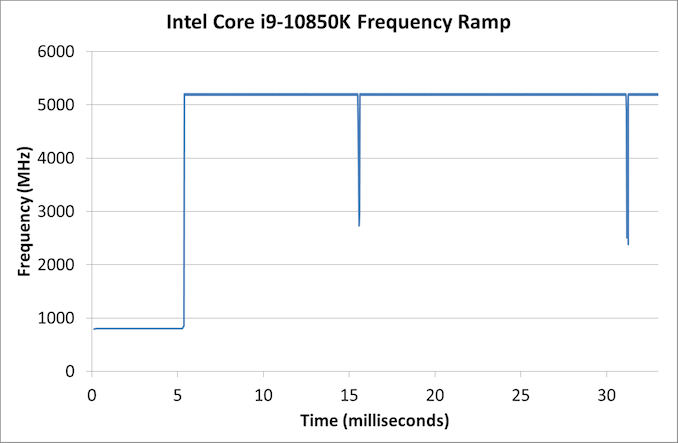Intel Core i9-10850K Review: The Real Intel Flagship
by Dr. Ian Cutress on January 4, 2021 9:00 AM EST- Posted in
- CPUs
- Intel
- Core
- Z490
- 10th Gen Core
- Comet Lake
- LGA1200
- i9-10850K
CPU Tests: Microbenchmarks
Core-to-Core Latency
As the core count of modern CPUs is growing, we are reaching a time when the time to access each core from a different core is no longer a constant. Even before the advent of heterogeneous SoC designs, processors built on large rings or meshes can have different latencies to access the nearest core compared to the furthest core. This rings true especially in multi-socket server environments.
But modern CPUs, even desktop and consumer CPUs, can have variable access latency to get to another core. For example, in the first generation Threadripper CPUs, we had four chips on the package, each with 8 threads, and each with a different core-to-core latency depending on if it was on-die or off-die. This gets more complex with products like Lakefield, which has two different communication buses depending on which core is talking to which.
If you are a regular reader of AnandTech’s CPU reviews, you will recognize our Core-to-Core latency test. It’s a great way to show exactly how groups of cores are laid out on the silicon. This is a custom in-house test built by Andrei, and we know there are competing tests out there, but we feel ours is the most accurate to how quick an access between two cores can happen.
When we first reviewed the 10-core Comet Lake processors, we noticed that a core (or two) seemed to take slightly longer to ping/pong than the others. We see the same pattern here again with the final core.
Frequency Ramping
Both AMD and Intel over the past few years have introduced features to their processors that speed up the time from when a CPU moves from idle into a high powered state. The effect of this means that users can get peak performance quicker, but the biggest knock-on effect for this is with battery life in mobile devices, especially if a system can turbo up quick and turbo down quick, ensuring that it stays in the lowest and most efficient power state for as long as possible.
Intel’s technology is called SpeedShift, although SpeedShift was not enabled until Skylake.
One of the issues though with this technology is that sometimes the adjustments in frequency can be so fast, software cannot detect them. If the frequency is changing on the order of microseconds, but your software is only probing frequency in milliseconds (or seconds), then quick changes will be missed. Not only that, as an observer probing the frequency, you could be affecting the actual turbo performance. When the CPU is changing frequency, it essentially has to pause all compute while it aligns the frequency rate of the whole core.
We wrote an extensive review analysis piece on this, called ‘Reaching for Turbo: Aligning Perception with AMD’s Frequency Metrics’, due to an issue where users were not observing the peak turbo speeds for AMD’s processors.
We got around the issue by making the frequency probing the workload causing the turbo. The software is able to detect frequency adjustments on a microsecond scale, so we can see how well a system can get to those boost frequencies. Our Frequency Ramp tool has already been in use in a number of reviews.
The Core i9-10850K ramps up extremely quickly from idle to peak turbo, in the region of about 5 milliseconds. This is faster than the 16 ms we typically observe.












126 Comments
View All Comments
edzieba - Monday, January 4, 2021 - link
I dunno, sounds like an opportunity for ambient-pressure water phase-change cooling to me! Who needs evacuated heat-pipes or vapour-chambers when you can just spray the top of the IHS directly!shabby - Monday, January 4, 2021 - link
Hey Ian can you put the real cpu wattage in the charts that the cpu used in that test rather than the fake one? We all know this cpu never uses 125 watts.Drkrieger01 - Monday, January 4, 2021 - link
You either skipped the 'Power Consumption' page, or don't understand CPU TDP ratings. The '125W' rating is the 'non-turbo' rating, meaning power consumed at max non-turbo clock rate. AMD does the same thing, and also has a higher power consumption during turbo (although not anywhere near as much as Intel does).shabby - Monday, January 4, 2021 - link
Since each benchmark varies it would be nice seeing how much wattage each cpu used during that benchmark.Yes i know amd uses more power during turbo, the 5950x uses 30 watts more than advertised... compared to ~140 watts more that intel advertises their 10850k to use. That quite the difference don't you think?
Drkrieger01 - Monday, January 4, 2021 - link
Unless you're working on a power budget, I honestly wouldn't worry about it. Most review websites don't have the time/man-power to trace the power usage on each benchmark for each CPU. You will also have a variance between processors of the exact same model due to binning/silicon lottery. You're better off planning to use/dissipate the full turbo power of the CPU than hope for lower power. Or just buy an AMD (if you can find one!)eek2121 - Monday, January 4, 2021 - link
Actually AMD chips use the TDP value as the maximum power value minus the IO power, so all AMD chips use a total of 143 watts at maximim.Flunk - Monday, January 4, 2021 - link
Intel seems to have six similar i9 SKUs with prices ranging from $453 to $488. Seems rather pointless. Maybe Intel marketing should spend some time thinking about whether or not their insanely complex model scheme is contributing to their lack of sales. AMD has ONE SKU that competes with all of those Intel SKUs. Clock down for lower TDP doesn't need to be an entire SKU.Duwelon - Monday, January 4, 2021 - link
Whoever comes up with Intel's SKUs must be the same person/people responsible for interfacing with USB Implementers Forum on Intel's behalf. The industry is replete with remarkably confusing naming schemes, seemingly on purpose.DanNeely - Monday, January 4, 2021 - link
Making the low power versions use the same model number would be a very anti-consumer move because you'd have no easy way to know if you were getting the 3.7Ghz or 1.9Ghz model. We already have that problem on mobile where two laptops with identical specs perform wildly different because one is running the CPU at 2x the power/performance of the other. Using separate model numbers also lets you bin chips that perform best at low and high power levels separately.The production limit bins (10850K and both IGPless KF models) muddle things up a bit; but Intel's desktop lines are very cleanly broken out vs what they did a decade+ ago with a mess of different similar chips with varying cache sizes and clock speeds but the same core counts; or the ongoing mess of their mobile line (good luck figuring anything out about one of those chips from its model number without looking it up).
Crazyeyeskillah - Monday, January 4, 2021 - link
they have various skus for oem's, system builders, general public, retail products, ect ectCertain OEMs require a non-open market skus to promote their products or run at certain specs that differentiate them from what's available on the open market.